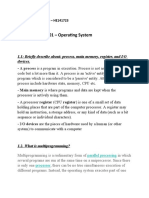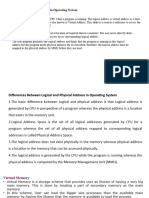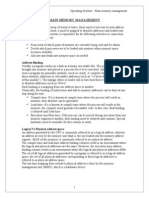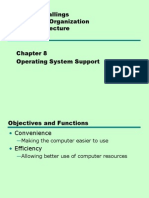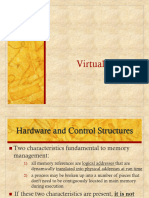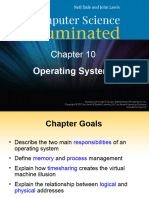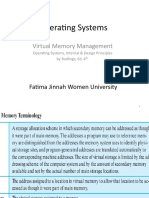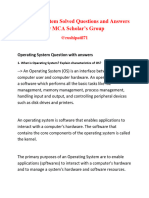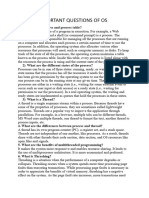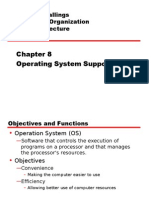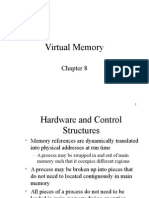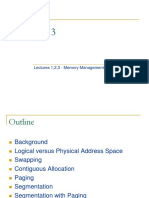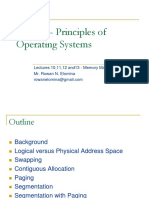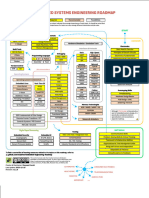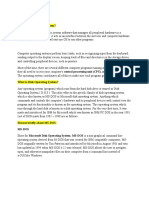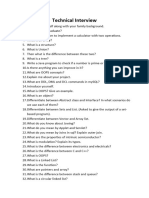Chapter Page Table
1. Page Table is a data structure used by the virtual memory system to
store the mapping between logical addresses and physical addresses.
2. Logical addresses are generated by the CPU for the pages of the
processes therefore they are generally used by the processes.
3. Physical addresses are the actual frame address of the memory.
4. Physical addresses are generally used by the hardware or more
specifically by RAM subsystems.
5. The CPU always accesses the processes through their logical addresses.
6. Memory Management converts the page number of the logical address
to the frame number of the physical address.
7. Memory Management unit needs a special kind of mapping which is
done by page table.
8. The page table stores all the Frame numbers corresponding to the page
numbers of the page table.
9. The page table maps the page number to its actual location (frame
number) in the memory.
10.CPU generates logical address for each page of the process. This
contains two parts: Page number and offset.
11.To determine the actual page number of the process, CPU stores the
page table base in a special register.
12.Each time the address is generated, the value of the page table base is
added to the page number to get the actual location of the page entry in
the table. This process is called scaling.
13.The frame number of the desired page is determined by its entry in the
page table.
14.The frame number and the offset from the physical address is mapped
to the main memory in order to get the actual word address.
Process Management in OS
15.A Program does nothing unless its instructions are executed by CPU. A
program in execution is called a process.
16.The operating system has to manage all the processes and the resources
in a convenient and efficient way.
�17.Some resources may need to be executed by one process at one time to
maintain the consistency otherwise the system can become inconsistent
and deadlock may occur.
18.The Attributes of the process are used by the Operating System to
create the process control block (PCB) for each of them.
19.When a process is created, a unique id is assigned to the process which
is used for unique identification of the process in the system.
20.A program counter stores the address of the last instruction of the
process on which the process was suspended.
21.The Process, from its creation to the completion, goes through various
states which are new, ready, running and waiting etc.
22.The process with the highest priority among the processes gets the CPU
first. This is also stored on the process control block.
23.Every process has its own set of registers which are used to hold the
data which is generated during the execution of the process.
24.During the Execution, Every process uses some files which need to be
present in the main memory.
25.OS also maintain the list of all open devices which are used during the
execution of the process.
26.A program which is going to be picked up by the OS into the main
memory is called a new process.
27.Whenever a process is created, it directly enters in the ready state, in
which, it waits for the CPU to be assigned.
28.The OS picks the new processes from the secondary memory and put all
of them in the main memory.
29.The processes which are ready for the execution and reside in the main
memory are called ready state processes.
30.One of the processes from the ready state will be chosen by the OS
depending upon the scheduling algorithm.
31.From the Running state, a process can make the transition to the block
or wait state depending upon the scheduling algorithm or the intrinsic
behavior of the process.
32.When a process finishes its execution, it comes in the termination state.
33.A process in the ready state, which is moved to secondary memory from
the main memory due to lack of the resources (mainly primary memory)
is called in the suspend ready state.
�34.If the main memory is full and a higher priority process comes for the
execution then the OS have to make the room for the process in the
main memory by throwing the lower priority process out into the
secondary memory.
35.Instead of removing the process from the ready queue, it's better to
remove the blocked process which is waiting for some resources in the
main memory.
36.Once the process is created, it will be ready and come into the ready
queue (main memory) and will be ready for the execution.
37.Out of the many processes present in the ready queue, the Operating
system chooses one process and start executing it. Selecting the process
which is to be executed next, is known as scheduling.
Segmentation in OS (Operating System)
38.Segmentation is a memory management technique in which the
memory is divided into the variable size parts. Each part is known as a
segment which can be allocated to a process.
39.The details about each segment are stored in a table called a segment
table.
40.Segment table contains mainly two information about segment:
1. Base: It is the base address of the segment
2. Limit: It is the length of the segment.
41.Paging is more close to the Operating system rather than the User.
42.Each segment contains the same type of functions such as the main
function can be included in one segment and other functions can be
included in other segment.
43.The operating system also generates a segment map table for each
program.
44.With the help of segment map tables and hardware assistance, the
operating system can easily translate a logical address into physical
address on execution of a program.
45.The Segment number is mapped to the segment table.
46.If the offset is less than the limit then the address is valid otherwise it
throws an error as the address is invalid.
47.In the case of valid addresses, the base address of the segment is added
to the offset to get the physical address of the actual word in the main
memory.
� Virtual Memory
48.Virtual Memory is a storage scheme that provides user an illusion of
having a very big main memory.
49.In Virtual Memory User can load the bigger size processes than the
available main memory by having the illusion that the memory is
available to load the process.
50.In demand paging, the pages of a process which are least used, get
stored in the secondary memory.
Memory
51.Computer memory can be defined as a collection of some data
represented in the binary format.
52.A computer device that is capable to store any information or data
temporally or permanently, is called storage device.
53.Computer converts every data into binary language first and then stores
it into the memory.
54.Signed bit value 0 represents positive integer while 1 represents
negative integer.
55.If the size of the main memory is larger than CPU can load more
processes in the main memory at the same time and therefore will
increase degree of Multi programming as well as CPU utilization.
THE END
